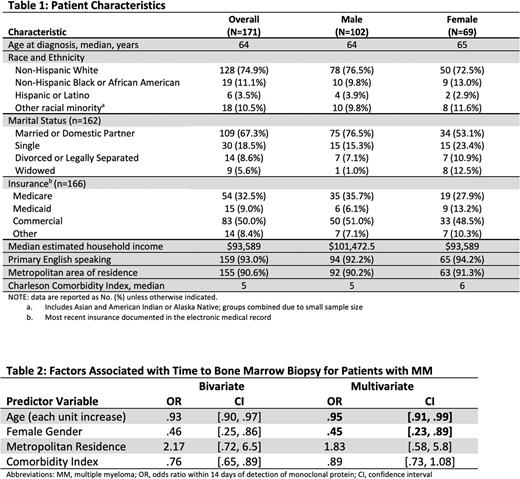Abstract
Introduction: Multiple myeloma (MM) is one of the most diagnosed hematologic malignancies in the United States. Despite improvements in therapy, health disparities persist with regard to income, race and ethnicity, and gender (Fiala et. al. Cancer 2017; Waxman et. al. Blood 2010; Boyd et. al. Cancer Epidemiol Biomarkers Prev 2011). One potential reason for these disparities is a delay in diagnosis. The time to diagnosis (TTD), measured by the time interval between clinical suspicion and pathologic confirmation, is prolonged for vulnerable patient populations with solid malignancies, and is thought to contribute to worse survival. Less is known about whether such diagnostic delays exist among patients within hematologic malignancies. Here, we aim to determine whether there are disparities in TTD among patients with MM by income, race or ethnicity, or gender.
Methods: We extracted data on patients with a bone marrow biopsy (BMB) confirmed diagnosis of MM between May 2003 - May 2022 from the University of Washington's electronic medical record (EMR). The primary outcome measure was whether the BMB was performed within 14 days after the initial detection of a monoclonal protein in the serum or urine. Predictor variables include race, ethnicity, gender, and insurance as identified in the EMR, as well as estimated median household income using patient zip code and data from the U.S. Department of Agriculture Economic Research Service. Performance status was not uniformly collected in the EMR, thus the Charlson Comorbidity Index (CCI) was utilized as a proxy for health status and calculated by extracting comorbidities from the EMR. Except for age and income, which were measured as continuous variables, the predictor variables were dichotomized. We assessed whether the predictor variables were associated with the primary outcome measure. We utilized bivariate analyses to identify measures with p < 0.20 for inclusion in a multivariate logistic regression model.
Results: Of the 171 patients eligible for this analysis, the median age was 64.6 years (35.6 - 101.0); 69 (40.4%) identified as female and 43 (25.2%) identified as a racial or ethnic minority. The vast majority (159; 93.0%) spoke English as their primary language and resided in a metropolitan region (155; 90.6%). Most patients were married (109; 67.3%) and insured either via commercial insurance (83; 50.0%), Medicare (54; 32.5%), or Medicaid (15; 9.0%). The median CCI was 5 (2-11). The median annual household income was $93,589 ($46,678 - $102,624) (Table 1).
Of the predictor variables, age, gender, residence, and CCI were associated with the primary outcome measure in the bivariate analysis and were included in the multivariate model. In the multivariate analysis, only age and gender were associated with TTD. Elderly patients (OR 0.95 [C.I. 0.91-0.99]) and female patients (OR 0.45 [C.I. 0.23-0.89]) were less likely to receive a BMB within 14 days of detecting the initial monoclonal protein in the urine or serum (Table 2).
Conclusions: Although there were no differences in time to biopsy by race or ethnicity, our study did identify disparities by gender and age. Advancing age and female gender were associated with a decreased odds of receiving a BMB within 14 days of the preceding lab abnormality. While we are unable to confirm the reason for the delay, systematic reviews assessing delayed TTD in solid malignancies have found that patient factors such as fear, provider factors such as miscommunication, and systemic factors such as lack of coordination of patient records all may contribute to diagnostic delay (Reece et. al. BMC Cancer 2021). Additionally, patient-physician gender discordance has been associated with reduced rate of cancer screenings (Malhotra et. al. Cancer Epidemiol Biomarkers Prev 2017) and may also be relevant to disparities in TTD among patients with hematologic malignancies. Although neither age nor gender specific delays in TTD have been systematically assessed, patient, provider, and systemic factors likely all contribute.
This is the first study to our knowledge examining disparities in TTD among patients with MM. Further studies need to be conducted to elucidate reasons for delays and the potential impact on more distal outcomes such as survival. Additional work to characterize disparities among patients with MM is necessary to develop effective and equitable interventions to reduce those correctable discrepancies.
Disclosures
Menon:GSK Open Africa Lab: Research Funding; Cepheid Diagnostics: Research Funding.
Author notes
Asterisk with author names denotes non-ASH members.


This feature is available to Subscribers Only
Sign In or Create an Account Close Modal